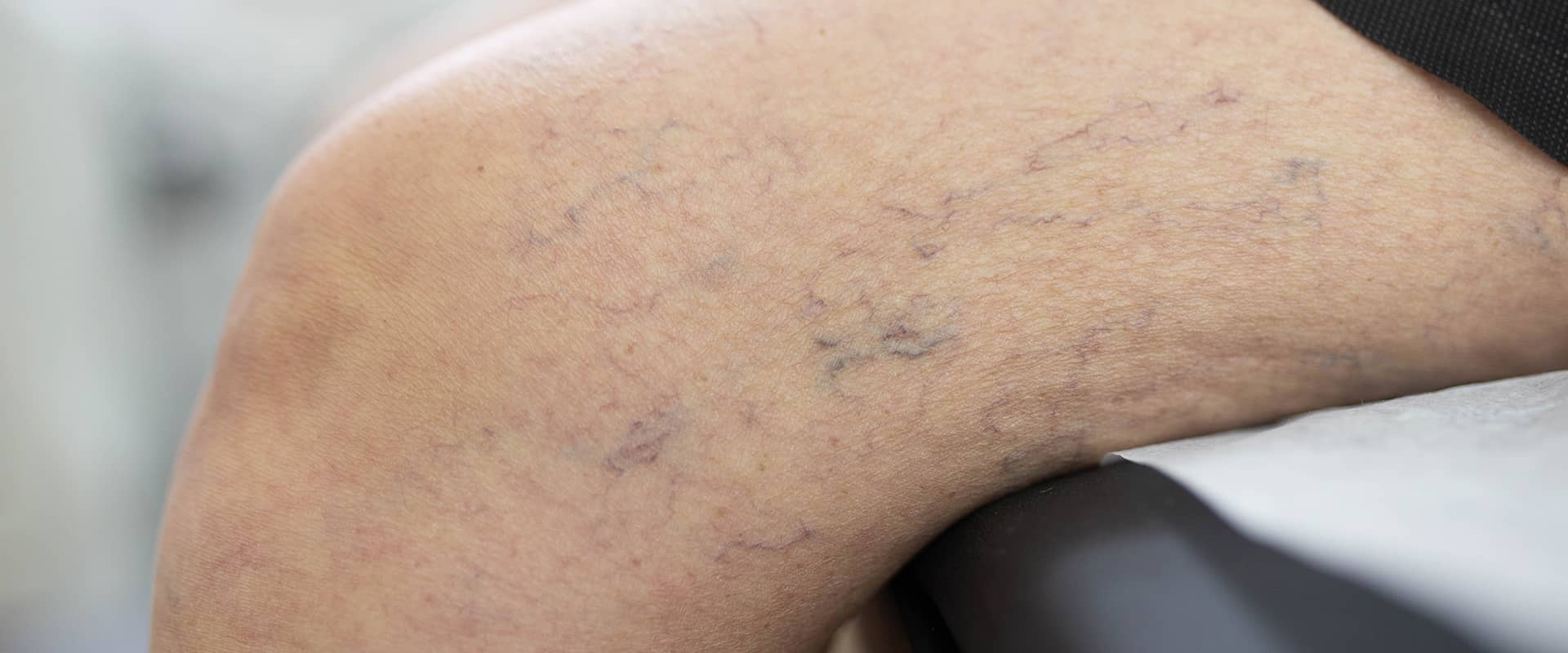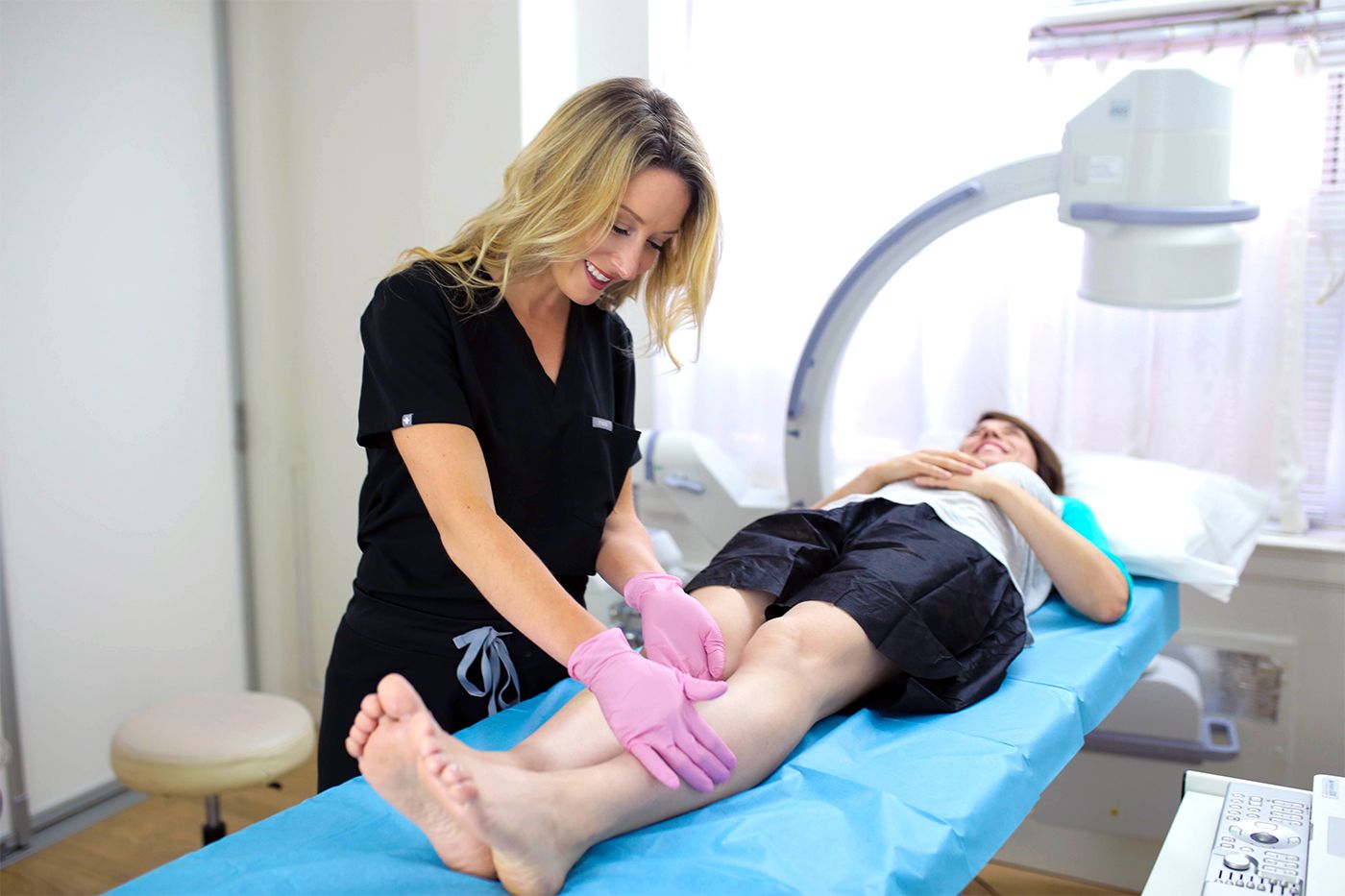How can you get rid of Spider Veins?
About 50% of adults have vein disease, which includes the commonly known symptoms of varicose veins and spider veins on legs. Usually, people assume that having your legs covered in varicose and spider veins is only a cosmetic issue, when in reality, spider veins can cause additional medical symptoms such as frequent leg cramping, leg heaviness, and even skin discoloration on legs. When your symptoms evolve in such a way, it tends to be a clear sign of having an underlying issue that needs medical attention from a certified vein doctor. Read along to learn about what exactly causes spider veins, how to find out if they are related to an underlying illness, how to get rid of spider veins, and whether or not insurance will help cover your treatment.

What Are Spider Veins (AKA Telangiectasias)?
Spider veins, which are also known as telangiectasias, are small, dilated veins that appear near the surface of the skin. They are usually red, purple, blue, or a combination of those colors. More often than not, spider veins are located on the legs, althought they can certainly appear on hands, nose and overall face.
An important detail to make note of is that spider veins are not to be confused with varicose veins. Although very similar, varicose veins are usually larger than spider veins. Varicose veins can also push against the skin’s surface in a protuberant manner.
What Causes Spider Veins?
Spider veins are caused by weak or damaged valves within your veins. When your heart pumps blood it pushes it first through the arteries, which carry blood out to the limbs. After the oxygen is removed from the blood, it returns to the heart through your veins. The veins in your legs have one-way doors called valves that only let blood move in a single direction. After the blood passes through a valve, the valve closes, preventing the blood from falling back down to the feet with gravity.
If the valves become weak, then the blood can move backward, where it collects in the veins. Doctors call this chronic venous insufficiency.
While chronic venous insufficiency is the underlying cause of some varicose veins, vein experts know that several factors can contribute to spider vein development. Some of the most common causes include:
- Genetics: A family history of vein disease
- Obesity: Excess weight puts pressure on your vein.
- A history of blood clots: Blood clots destroy the valves within your veins.
- Ocupation: Working a job that requires you to stand for long hours.
- Hormone therapy: Hormone replacement or even taking birth control pills.
- Pregnancy: Increased circulating female hormones and pressure on the veins in the pelvis.
If you want to avoid varicose veins and spider veins, you can make some lifestyle decisions that will lower your susceptibility.

Why Are Spider Veins a Problem?
Some people want to get rid of spider veins solely because they don’t like how they look. If spider veins make you feel self-conscious, then you may avoid activities that involve exposing your legs. That could mean that you don’t join friends and relatives when they go to the beach or visit a swimming pool. Some people report spider veins having a significant negative impact on their self-esteem, causing them to become less outgoing and adventurous.
You may also want to get rid of spider veins because of the painful physical symptoms that you find problematic. For instance, spider veins can cause an aching feeling in your legs. If you have spider veins, you may experience muscle cramps, burning sensations, and throbbing in your lower legs. Other symptoms include:
- Bleeding from the veins
-
Skin inflammation
- Skin ulcers.
- Pain, especially after standing or sitting for a prolonged amount of time.
Some symptoms, including hardening of the vein and inflammation, can indicate that you have a vascular disease that puts your health at risks and requires medical attention from an experienced vein treatment specialist.
Book a Consultation
Scheduling a consultation with one of our vein treatment experts is one of the best ways to determine the proper resolution for your varicose veins. The treatments can include sclerotherapy, laser or radiofrequency ablation, a medication called Varithena, or procedures such as Venaseal, or Clarivein.
What’s the Best Way to Get Rid of Spider Veins?
The best way to get rid of spider veins depends on whether you have chronic venous insufficiency. If you don’t have chronic venous insufficiency, then you should visit a vein doctor in New York or New Jersey for a cosmetic or sclerotherapy treatment.
Sclerotherapy involves injecting a small amount of medication into your spider veins. The medication (called a slcerosant) damages the lining of your vessel. As a result, the vein seals closed and over time fades and disappears.
Sclerotherapy usually takes about 10 to 30 minutes for a vein doctor to perform. During this time, you will have your leg elevated so the blood will drain and create room for the sclerotherapy. You’ll want to wear compression stockings for several days after the treatment to help the medication be as effective as possible.
If you have chronic venous insufficiency, then you can use sclerotherapy in combination with endovenous ablation to treat the condition. Without endovenous ablation, there is a good chance that the spider veins will return.
In this case, you will need your New York or New Jersey vein doctor to treat the underlying refluxing veins. You may need to undergo a procedure called endovenous laser ablation to get rid of spider veins. Endovenous laser ablation uses laser technology to close the vein permanently.
During the procedure, which usually takes 30 to 45 minutes, your vein doctor will use a local anesthetic to prevent any pain.. The treatment has a 97% success rate, so it’s a great option to get rid of spider veins when chronic venous insufficiency is present.
Will my insurance cover Spider Vein Removal?
Most insurance companies will pay for treatments only if you have valvular reflux in addition to spider vein symptoms. Without valvular reflux, insurance companies typically consider the treatments cosmetic, so they won’t cover the cost.

Is there a Spider Vein doctor specifically?
It’s important that you choose a certified, dedicated vein treatment specialist in your quest to get rid of spider veins. Vein disease and vascular physicians have undergone specialized training that helps them identify the complex underlying cause of spider veins and other vein related issues.
You can find certified vein doctors at the Spider and Varicose Vein Treatment Center, with multiple locatins in New York, New Jersey, San Diego, CA and Houston, Tx. If you have any questions about spider veins, endovenous laser ablation, or any other procedure that eliminates spider veins, you can contact the Vein Treatment Center online or by calling their national line 888-827-7441.

Request an appointment
We are one of the top spider vein and varicose vein treatment centers in the Nation, offering the latest treatments and the most state of the art technology. Our vein treatment center sources the best vein doctors and specialists from around the world.
Covered by most insurances, including Medicare.
Enter your information below to get started
Questions? Call us 888-827-7441
By emailing us or contacting us via web form, you are accepting the inherent privacy limitations of online communication. For more information about internet privacy, please read our Communication by Email/Text document. Please respond “stop” to text messages to opt out.






